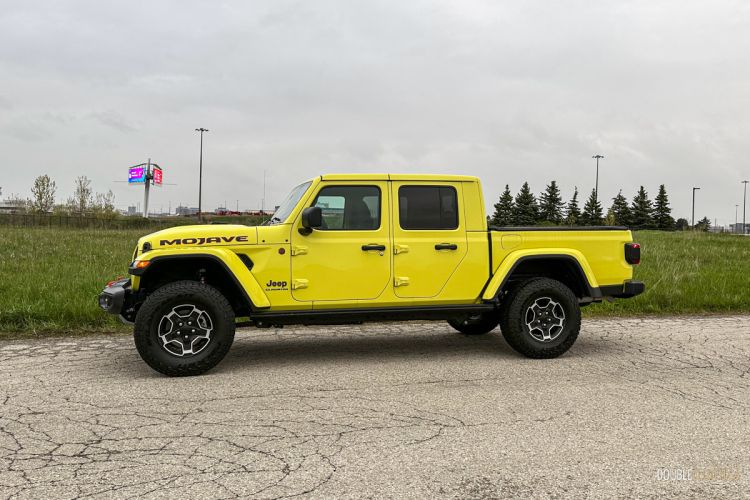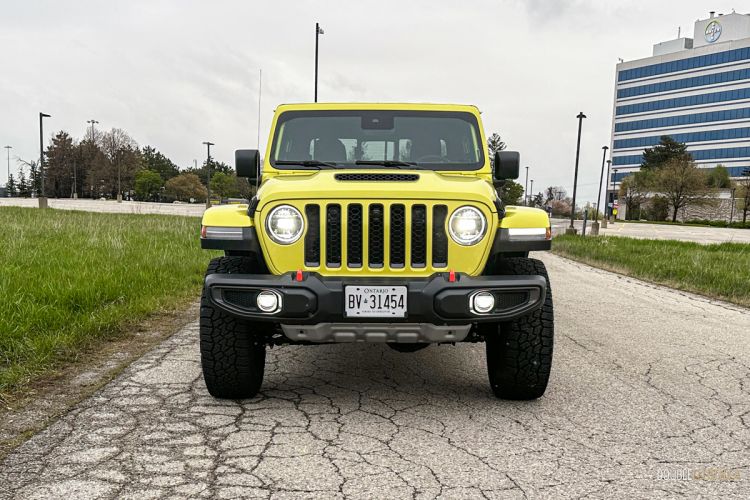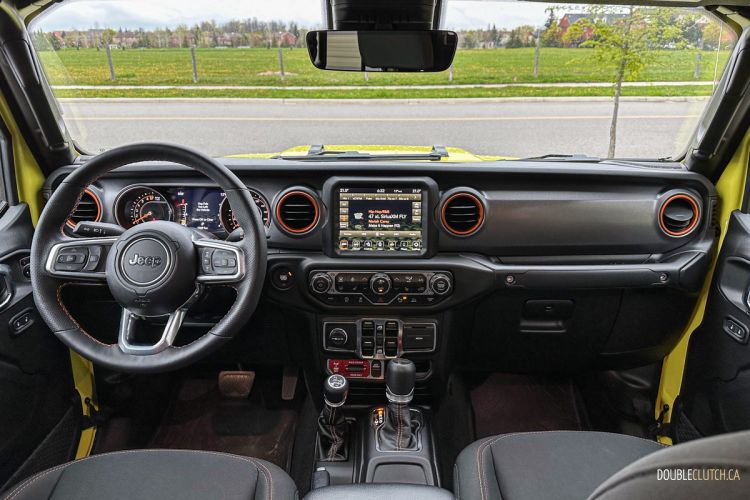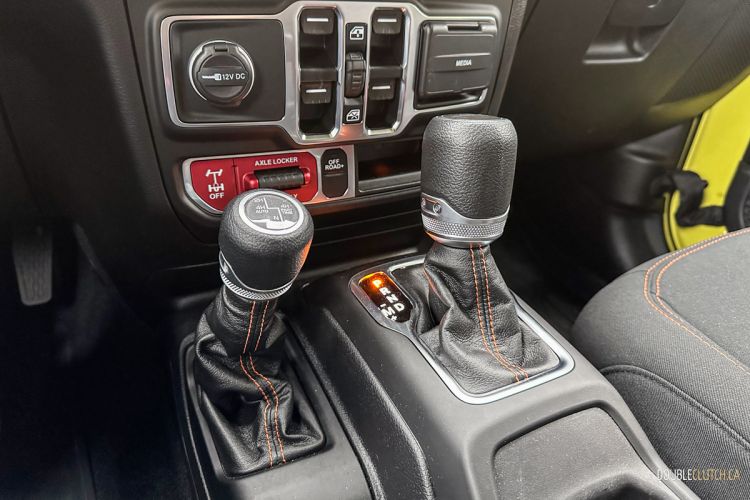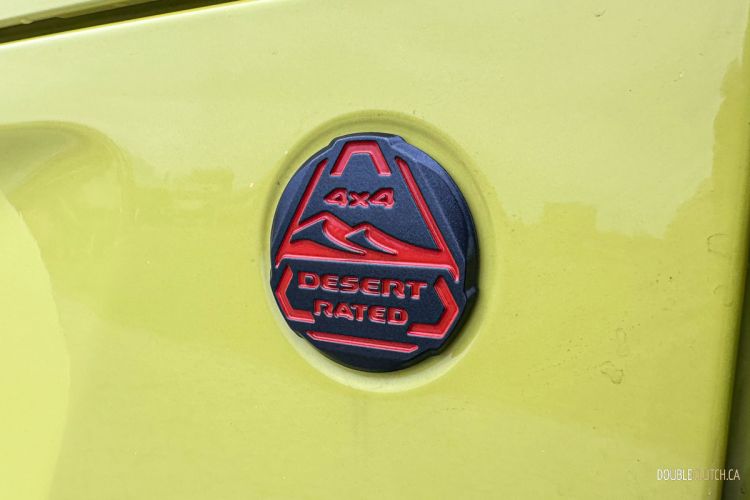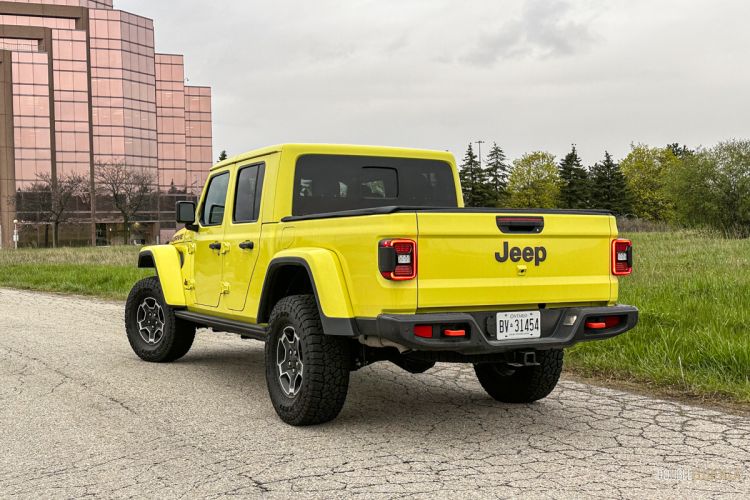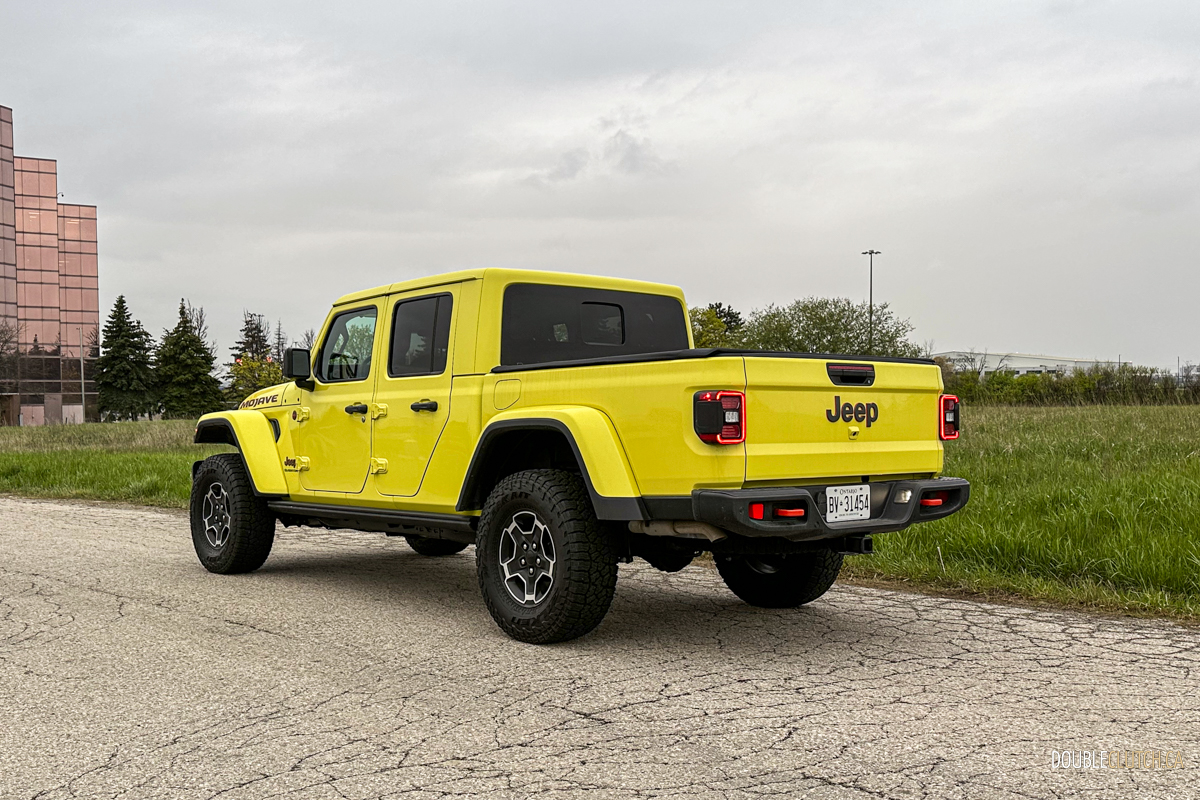Spring is finally in the air here in Toronto, and if you’re like me that means two things; open air motoring and yard work. That’s where this curious beast, the Jeep Gladiator comes in. Essentially an extended Wrangler with a bed, it aims to add some practicality to the ever-popular Wrangler platform. We had the chance to put a new 2023 Jeep Gladiator Mojave through its paces with a little bit of commuter duty, some kid shuttling and some projects in the yard to see how versatile it can really be.
On the outside the Gladiator fully embraces the traditional Jeep Wrangler styling, with all the traditional Jeep cues. The platform has been stretched significantly though with a larger cab for passengers and the addition of a five-foot bed. The extra length and addition of a bed do look a little awkward against the traditional Wrangler proportions, but real Jeeps are all about function over form, so the slightly awkward looks are forgivable here.
Our tester, on the other hand, came finished in High Velocity Yellow, which only served to attract tons of attention to the already questionably styled truck. That said, if you direct your attention away from the colour you’ll find that the Gladiator Mojave’s exterior offers up some serious hints to what lies beneath the skin; 33-inch Falken Wildpeak all-terrain tires on 17-inch rims, color coordinated FOX shocks, a one-inch front lift, Desert Rated badging, and orange accenting all tell the story about what this truck was designed to do.
Equipped similarly to the Gladiator Rubicon, and priced identically, the Mojave is setup for higher speed off-roading, like you’d find in the desert or tundra, versus the Rubicon which is built for lower speed situations like rock crawling. To achieve this the Mojave removes the Rubicon’s locking front differential and sway bar disconnects, in favor of a reinforced frame, massive 2.5-inch FOX shocks and the one-inch front lift.
In addition to the obvious off-road prowess that’s associated with every Wrangler or Gladiator, and especially the Mojave trim like this one, the Gladiator offers impressive truck-like capabilities that can go head-to-head with any mid-size pickup truck in the market today. The standard naturally aspirated 3.6-liter V6 makes 285 horsepower and 260 lb-ft. of torque, which can be fed to the wheels through a six-speed manual, or an eight-speed automatic as equipped in our tester.
This allows a properly equipped Gladiator to tow up to 7,650 pounds, or up to 1,700 pounds of payload, which means the Gladiator offers best-in-class towing for gas powered mid-size trucks, and best-in-class payload for 4×4 mid-sizers, impressive for a company that isn’t usually associated with pickup trucks. While the five-foot bed length is adequate for most DIY homeowners, the one grip I ran into is the shallowness of the bed; the short sides mean that a lot more of the load is exposed.
The interior is much more practical and remains very similar to what you would find in a Wrangler, only with a lot more leg room in the back thanks to the longer wheelbase. Climbing up into the lifted Mojave, with only that thin rock rail to stand on takes some care, but once you’re in, you’re presented with a highly functional and rugged space. The dash is short and contains all key controls in a simple and clearly labeled layout, with real buttons and knobs! There is an 8.4-inch touchscreen (on Overland and higher trim levels) running the excellent Uconnect system and offering features like Wifi hotspot, Apple CarPlay, Android Auto, etc. The best news is that the screen is strictly for infotainment purposes, so you’re not at it’s mercy all the time.
Window switches are also on the dash, which allows for easy removal of the doors – because Jeep. The center console is busy with the traditional style automatic gear selector, the 4×4 selector – which is also a traditional level, and the lever-style parking brake, but there’s still room for two generous cup holders and a larger storage bin. In the back, amenities are sparse, but the additional legroom was appreciated by the kids.
In fact, amenities are generally sparse throughout, which isn’t a surprise if you’ve been around Jeeps, but there’s an argument that the price points the Gladiator hits should warrant some additional luxuries, though that is not the case. You get durable cloth seats with manual adjustment, dual climate control, and most of the basics you’d expect in a modern vehicle. Beyond that, even in the near top-line Mojave trim, there are a couple option packages you can select to add some additional features such as a cold weather package ($1,095) which adds heated seats, steering wheel and remote start; and an Advanced Safety Group ($1,450) adding electronic driver aids such as adaptive cruise control, advanced brake assist, forward collision warning and brake assist, etc.
On the flip side of that, the Gladiator comes standard with some features that no competitors have; the most notable being the open-air driving experience. Our tester came equipped with the optional ($2,450) Freedom three-piece body colored top, which is certainly a nice option to have, but there are quite a few ways setup your Gladiator with a top and doors system that will fit your needs. The Freedom top allowed us to quickly pop out the two front panels from the top and cruise around with the kids in the back, to enjoy the nice weather.
The driving experience itself is also unique to the Gladiator. While I am generally not a fan of the way the Wrangler drives, the Gladiator’s longer wheelbase solves one of my biggest gripes with the Wrangler and that’s the bouncy on-road ride quality. The longer wheelbase works wonders and as a result the Gladiator feels much more stable and comfortable on the highway. Downside is that the longer wheelbase means a reduced break-over angle and larger turning radius, but most drivers spend more time on the road, so I feel like the trade-off is to the Gladiators favour.
The 3.6L V6 is adequate and while the Gladiator doesn’t feel fast, it doesn’t break much of a sweat passing slower traffic and can pull away from a stop rather briskly when asked. Handling is impressive thanks for the desert turned suspension and fancy FOX shocks; steering is tight responsive and direct, and body motions are well controlled. The one ugly Jeep trait that still impacts the Gladiator is noise levels in the cabin, wind and road noise intrude on the closed cab bad enough to make long highway trips less enjoyable, if you’re the type to care about that.
Fuel economy is another weak point of the Gladiator. Going into a week with it I expected the fuel economy to be pretty bad, but real-world results came in worse than I imagined. After a week of mixed driving and a relatively light foot, our average sat at 16.1L/100km. That’s worse than any full-sized half-ton truck I’ve tested recently, and worse than the lifetime average economy in our personal Cadillac Escalade. It’s also much worse than the advertised numbers of 8.5L/100km highway and 10.8L/100km city. I am not sure how Jeep manages to get their V6 to consume so much fuel, but it’s definitely something to keep in mind.
The hit to the bank account doesn’t stop at the pumps unfortunately, as the Gladiator is quite pricey to get into as well, especially as you get into the higher trim levels. A base model Sport S starts at $53,490, and is an affordable way to get into the Jeep, especially if you’re going to build it to your personal tastes. The $60,590 Overland adds the black Freedom top, 18” wheels, the larger touchscreen, etc. Then there’s the Rubicon and Mojave at $64,190, which represent the true off-road setups, and finally the High Altitude at $70,480. That’s not it though, adding options to any of these trim levels can push the price up. For example, our Mojave tester with lots of option boxes checked rings in at $78,565, putting it well into top-trim half-ton pickup, or luxury SUV territory.
The 2023 Jeep Gladiator Mojave is a fascinating vehicle; the off-road capabilities of a true Jeep, but with class leading mid-sized pickup capabilities, and the versatility to handle the day-to-day family grind. It’s a fantastic do-it-all type vehicle that oozes character, and is something that the whole family can enjoy. That said, it does come with some big costs, from the price, to the fuel economy, and the lack of nice-to-have features, it’s not exactly a high value option if that’s what you’re seeking. That said, there’s nothing else like it.

